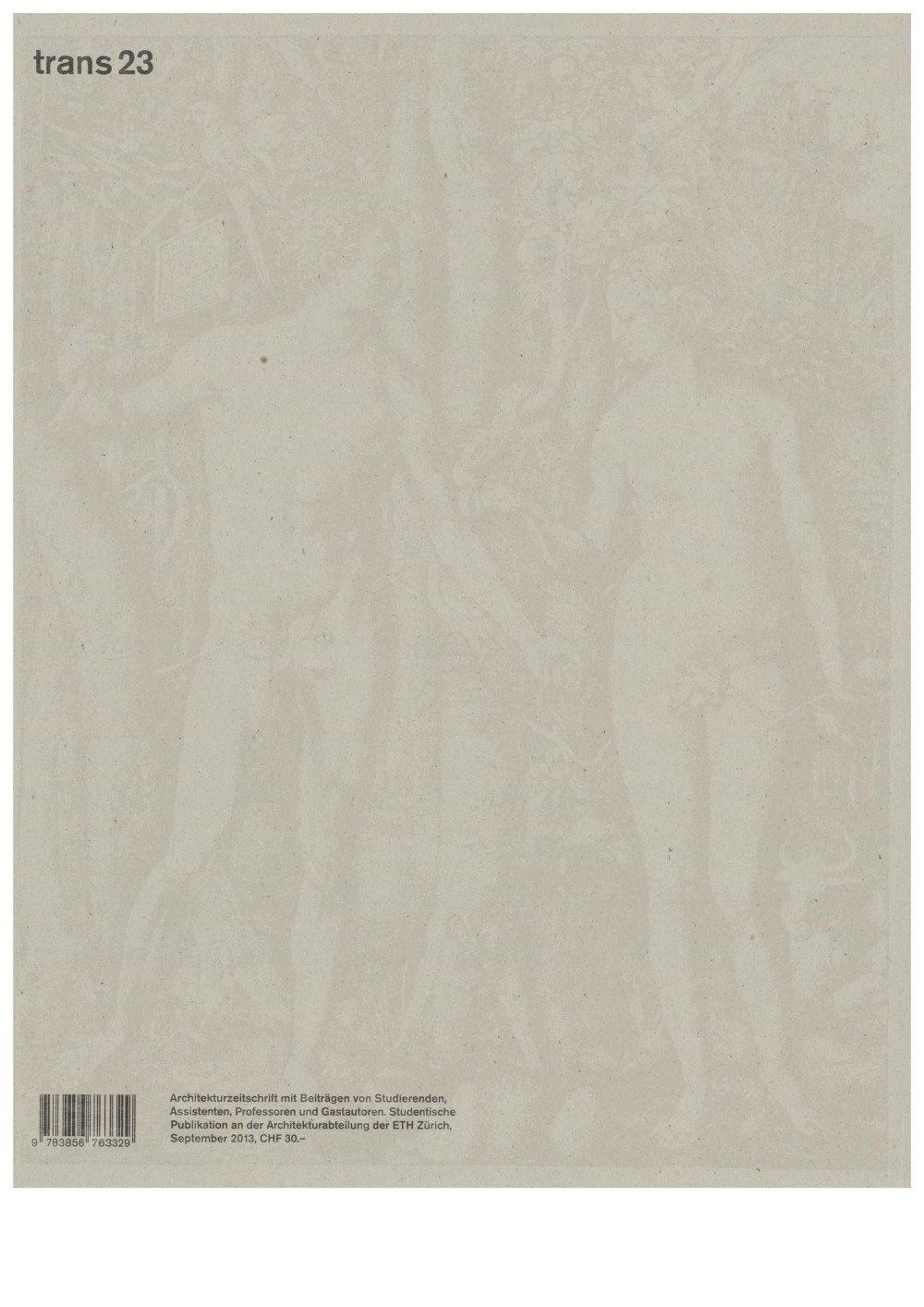«Oh Adam, what have you done!» The «fall of man» describes one of the most momentous events in Christian mythology: Adam's sin is not taken to be a sign of personal failure, but rather signifies the original sin of man. The tragic history of mankind is a history of transgressions and their consequences. After Eve tempts Adam to eat the forbidden fruit, both are expelled from the Garden of Eden.
With the 23rd issue of trans magazine, we seek the forbidden fruits of our time. Where are today's limits, by whom are they set and who goes beyond them?
In four topics the focus on limits ranges from the territorial and urban scale down to the boundaries of a house. Beyond this, these main topics are enriched by inputs in graphical, photographical or textual form that are in some cases nearer to, in other cases further away from the architectonic, or even go beyond the scope of the discipline.
What challenges does the architect have to meet? Under which circumstances is it possible to think big and to dare to do something? The present collection of contributions shows that behind apparent limits within the built environment, hidden, but stronger limits can be found: economic interrelations, political dependencies, social distortions and last but not least mental boundaries.
In 1494, at age 23, Albrecht Dürer embarked upon his first journey to Italy, travelling from Nürnberg across the Alps to Padua. There he came into direct contact with the works of Italian Quattrocento masters. This journey revealed a new world to Dürer, which was subsequently manifested in numerous drawings. «The engraving Adam and Eve», completed in 1504, is an expression of Dürers research on ideal proportions and throws a new light on the human being. Adam and Eve are depicted not as sinful, but as self confident individuals. They are willing to take the consequences of their actions. With the knowledge of good and bad, of cause and effect, comes the knowledge of their own mortality.
Overcoming boundaries and going beyond limits can have considerable consequences. Sometimes, entire epochs are enlightened, in other cases the effects are of a more subtle nature, reduced to the scale of a city, a school of architecture, or, perhaps, a magazine.
We wish you an enjoyable reading of the present issue.
Contributors
Fredi M.Murer, Marco Kistler, Sabrina Puddu & Francesco Zuddas, Vittorio Magnago Lampugnani, Kees Christiaanse, Patrik Schumacher, MiJung Manfrini-Capra, Stefan Jaeggi, Charlotte Malterre Barthes, Francesco Buzzi, Yasmine Sinno, Bruno Flierl, Tina Kilng & Steffen Hägele, Marc Schwarz, Seminar Architektur und Fotografie ETHZürich, StefanJaeggi & Tobias Wootton, Laura Baird, Winy Maas, Adam Caruso, Lukas Mersch &Nemanja Zimonjic, Eveline Althaus, Rebecca Bornhauser, Gion A. Caminada, Postgraduate Programme in Curating ZHdK, Jeanne van Heeswijk
Editorial Team
Julia Hemmerling, Christopher Metz, Annik Nemeth, Vanessa Schmitz
Table of content
Grenzen der Dichter und Denker
Kunsthaus Glarus
Hold the line : la stabilità della figura lineare
Autorenschaft im Städtebau : das Foro Bonaparte in Mailand
Weil wir Visionen brauchen
Free market urbanism : urbanism beyond planning
In perfetto equilibrio : architettura del movimento
Bloc : La Défense, Paris
The limits of control : informal city versus agriculture land on Cairo's fringes
La Città Ticino tra limiti e potenzialità
Terrain vague post crisis : exploring the thresholds of Barcelona
Ich benutze nicht das Wort "Wende"
São Paulo : hinter den Mauern einer Stadt
Raum und Bild
Architecture, not architects
It's too emotional!
The limits of architecture
Hidden Zurich
Nah und fremd : Nachbarschaften zwischen Öffnung und Abgrenzung
Die Allmede und ihre Grenzen
Schwellen in der Architektur
